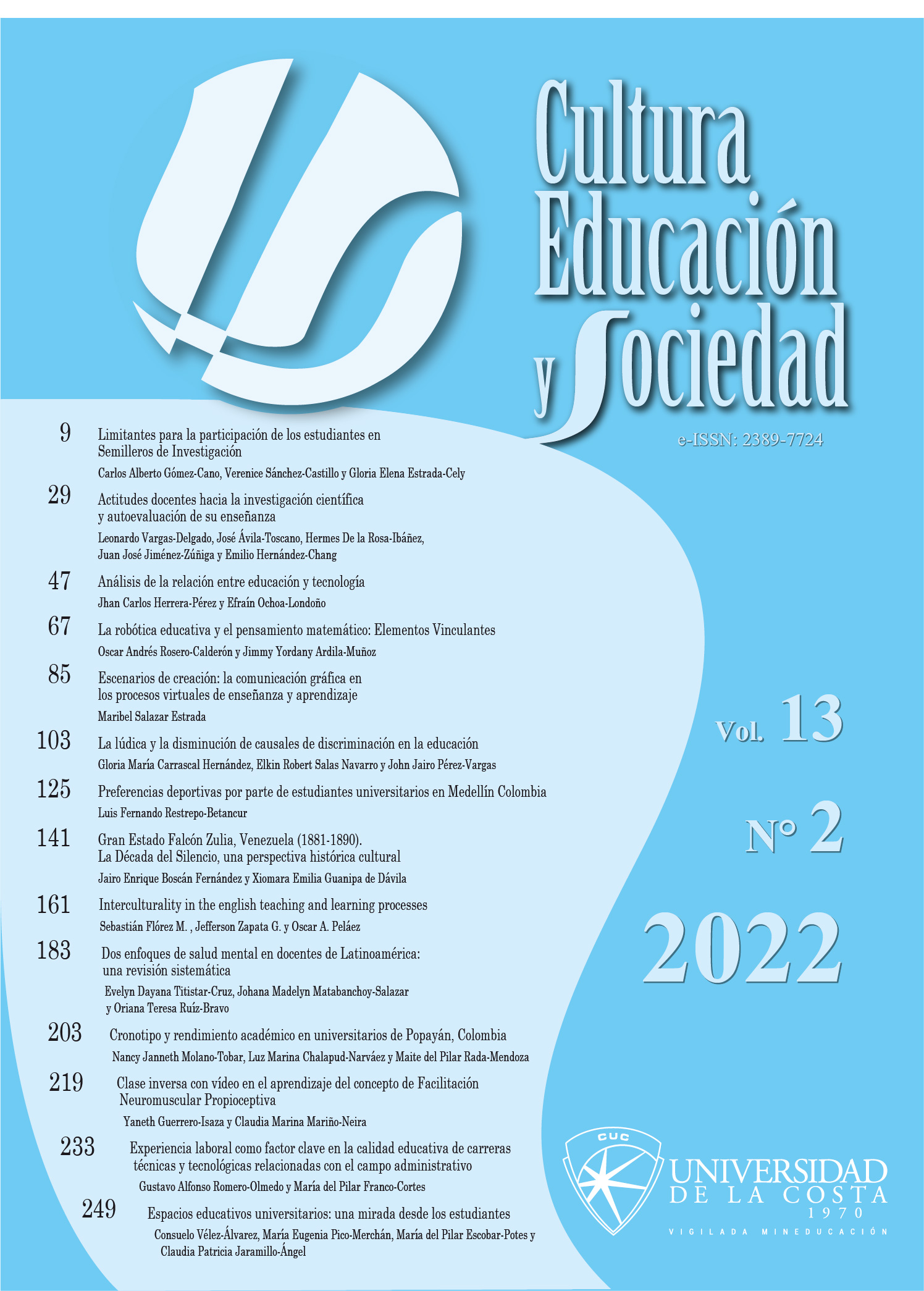Creation scenarios: graphic communication in virtual teaching and learning processes
DOI:
https://doi.org/10.17981/cultedusoc.13.2.2022.05Keywords:
Communication, Digitization, Education, Image, Sound, InteractionAbstract
Introduction: Currently, the changes caused by Information and Communication Technologies-ICT in areas such as education and communication are undeniable, for this reason, it is necessary to observe these impacts to recognize other ways of teaching and learn and enable training scenarios in accordance with a society in constant transformation. Objective: To analyze the incidence of graphic communication in the teaching-learning processes supported by ICT, based on the selected theory and the experiences of teachers and students of the Ude@ Virtual Education program of the University of Antioquia in Medellín (Antioquia, Colombia). Methodology: Includes a bibliographic review, to form a state of the art, and field work. As part of the systematization, the experiences of the actors are compared with the information obtained in a questionnaire. Results and discussion: They show the relationship between communication and ICT, from the integration of audiovisual resources to improve pedagogical practices in the context of teaching processes. Regarding the experiences, it was found that for the teacher, graphic communication enhances didactic mediation and for students, the relationship between ICT and graphic communication facilitates understanding and increases the degree of knowledge of the object. Conclusions: technology and its relationship with graphics is a support that enables other interactions and enriches the teaching and learning processes, both for the teacher and for the student.
Downloads
References
Arranz, V., Aguado, D. y Martínez, L. (2008). La influencia del tutor en el seguimiento de programas eLearning. Estudio de acciones en un caso práctico. Revista de Psicología del Trabajo y de las Organizaciones, 24(1), 5–23. https://doi.org/10.4321/s1576-59622008000100001
Brown, C. (2019, April 11). How technology can help improve education. Classcraft. https://www.classcraft.com/blog/how-has-technology-improved-education/
Camacho, J. y Bautista, D. (2017). La comunicación gráfica mediador de procesos de enseñanza aprendizaje de razonamiento lógico espacial. Experiencias pedagógicas y didácticas. https://recursos.educoas.org/publicaciones/la-comunicaci-n-gr-ficamediador-de-procesos-de-ense-anza-aprendizaje-de-razonamiento
Canales-García, A. y Araya-Muñoz, I. (2017). Recursos didácticos para el aprendizaje de la educación comercial: Sistematización de una experiencia en educación superior. Revista Electrónica Educare, 21(2), 151–173. https://doi.org/10.15359/ree.21-2.7
Kostolanský, L., Šebo, M. & Tomková, V. (2019, 1-3 July). The preparation of teachers in the field of multimedia education [Proceedings]. 11th International Conference on Education and New Learning Technologies, Palma, Spain. http://dx.doi.org/10.21125/edulearn.2019.0446
Freitas, A. y Paredes, J. (2022). Desafíos de la producción multimedia en los MOOC. Estudio de caso interpretativo sobre las perspectivas docentes. RIED. Revista Iberoamericana de Educación a Distancia, 25(1), 59–79. https://doi.org/10.5944/ried.25.1.30840
Gómez, L. (2011). Un espacio para la investigación documental. Revista Vanguardia Psicológica, 1(2), 226–233. https://dialnet.unirioja.es/descarga/articulo/4815129.pdf
Marta-Lazo, C., Gabelas-Barroso, J., Nogales-Bocio, A. y Badillo-Mendoza, M. (2022). Aprendizaje multimedia y transferencia de conocimiento en una plataforma digital. Estudio de caso de Entremedios. Revista Iberoamericana de Educación a Distancia, 25(1), 101–120. https://doi.org/10.5944/ried.25.1.30846
Martín-Barbero, J. (2004). Nuestra excéntrica y heterogénea modernidad. Estudios Políticos, (25), 115–134. https://revistas.udea.edu.co/index.php/estudiospoliticos/article/view/1401
Martín-Barbero, J. (2002a). III. Reconfiguraciones comunicativas del saber y del narrar. En, J. Martín-Barbero, La educación desde la comunicación (pp. 1–17). Editorial Norma.
Martín-Barbero, J. (2002b). La educación desde la comunicación. Editorial Norma.
Martín-Barbero, J. (2000). Retos culturales: de la comunicación a la educación. Nueva Sociedad, 169, 33–43. https://nuso.org/articulo/retos-culturales-de-la-comunicacion-a-la-educacion/
Martínez, L. M., Hernández-Sarmiento, J. M., Jaramillo-Jaramillo, L., Villegas-Alzate, J. D., Álvarez-Hernández, L. F., Roldan-Tabares, M. D., Ruiz-Mejía, C., Calle- Estrada, M. C. y Ospina-Jiménez, M. C. (2020). La educación en salud como una importante estrategia de promoción y prevención. Archivos de Medicina, 20(2), 490–504. https://doi.org/10.30554/archmed.20.2.3487.2020
Medina, N. I. (2010). La comunicación educativa y su aplicación en línea. Apertura, 2(2), 1–8. http://www.udgvirtual.udg.mx/apertura/index.php/apertura/article/view/139/155
Nanclares, L. y Tamayo, E. D. (2007). Physis videns: una estrategia didáctica para el aprendizaje de la física a partir de imágenes en movimiento. Educación y pedagogía, 48, 158–163. https://revistas.udea.edu.co/index.php/revistaeyp/article/view/6661?articlesBySimilarityPage=29
Fajardo, E. y Cervantes, L. C. (2020). Modernización de la educación virtual y su incidencia en el contexto de las Tecnologías de la Información y la Comunicación (TIC). Revista Academia y Virtualidad, 13(2), 103–116. https://doi.org/10.18359/ravi.4724
Prieto, D. (1998). Comunicación educativa en el contexto latinoamericano. Intervención Psicosocial, 7(3), 329–245. https://journals.copmadrid.org/pi/art/b3b4d2dbedc99fe843fd3dedb02f086f
Ríos, L. (2017). El mito de la recreación entre el activismo pedagógico y la acción formativa. Entornos, 30(1), 125–134. https://doi.org/10.25054/01247905.1433
Rodríguez, A. y Chávez, E. (2020). Cibernética educativa, actores y contextos en los sistemas de educación superior a distancia. Sophia, (28), 117–137. https://doi.org/10.17163/soph.n28.2020.04
Ulloa, G. & Díaz, C. (2018). Using an Audiovisual Materials-Based Teaching Strategy to Improve EFL Young Learners’ Understanding of Instructions. HOW Journal, 25(2), 91–112. https://doi.org/10.19183/how.25.2.419
Varguillas, C. S. y Bravo, P. C. (2020). Virtualidad como herramienta de apoyo a la presencialidad: Análisis desde la mirada estudiantil. Revista de Ciencias Sociales, 25(1), 219–232. https://doi.org/10.31876/rcs.v26i1.31321
Published
How to Cite
Issue
Section
License
Copyright (c) 2022 CULTURA EDUCACIÓN Y SOCIEDAD

This work is licensed under a Creative Commons Attribution-NonCommercial-NoDerivatives 4.0 International License.
![]()
Creative Commons 2020 CULTURA EDUCACIÓN Y SOCIEDAD
This article is under international license Creative Commons Reconocimiento-NoComercial-SinObrasDerivadas 4.0.
The published articles are the sole responsibility of their authors and do not necessarily reflect the opinions of the editorial committee.
CULTURA EDUCACIÓN Y SOCIEDAD respects the moral rights of its authors, who assign to the editorial committee the patrimonial rights of the published material. In turn, the authors inform that this work is unpublished and has not been previously published.
All articles are under a:
Licencia Creative Commons Atribución-NoComercial-SinDerivadas 4.0 Internacional.
![]()


 English
English
 Español (España)
Español (España)




_12.53_.27_p_. m_._3.png)





_12.57_.35_p_. m_._3.png)
_12.50_.37_p_. m_._3.png)



